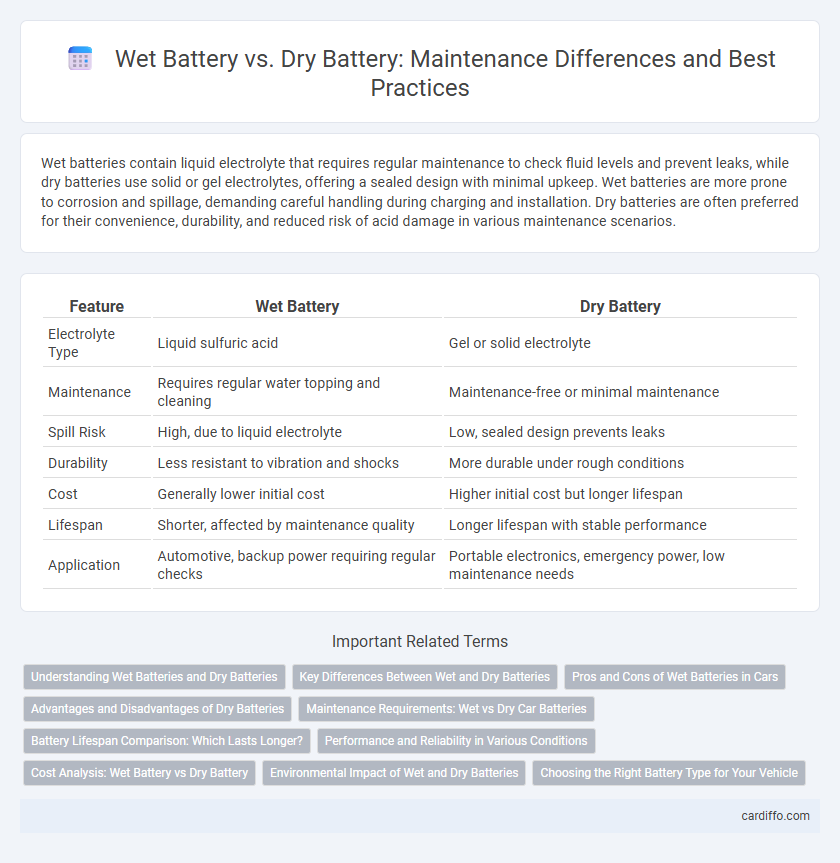Wet batteries contain liquid electrolyte that requires regular maintenance to check fluid levels and prevent leaks, while dry batteries use solid or gel electrolytes, offering a sealed design with minimal upkeep. Wet batteries are more prone to corrosion and spillage, demanding careful handling during charging and installation. Dry batteries are often preferred for their convenience, durability, and reduced risk of acid damage in various maintenance scenarios.
Table of Comparison
| Feature | Wet Battery | Dry Battery |
|---|---|---|
| Electrolyte Type | Liquid sulfuric acid | Gel or solid electrolyte |
| Maintenance | Requires regular water topping and cleaning | Maintenance-free or minimal maintenance |
| Spill Risk | High, due to liquid electrolyte | Low, sealed design prevents leaks |
| Durability | Less resistant to vibration and shocks | More durable under rough conditions |
| Cost | Generally lower initial cost | Higher initial cost but longer lifespan |
| Lifespan | Shorter, affected by maintenance quality | Longer lifespan with stable performance |
| Application | Automotive, backup power requiring regular checks | Portable electronics, emergency power, low maintenance needs |
Understanding Wet Batteries and Dry Batteries
Wet batteries contain liquid electrolytes and require regular maintenance, such as checking fluid levels and topping up distilled water to prevent corrosion and ensure optimal performance. Dry batteries, also known as sealed or valve-regulated lead-acid (VRLA) batteries, use immobilized electrolytes, making them maintenance-free and less prone to leakage or evaporation. Understanding these differences helps in selecting the appropriate battery type based on maintenance needs and application requirements.
Key Differences Between Wet and Dry Batteries
Wet batteries contain liquid electrolytes, requiring regular maintenance such as electrolyte level checks and refilling to prevent damage. Dry batteries use a solid or gel electrolyte, offering a sealed design that minimizes leakage and reduces maintenance needs. Wet batteries typically provide higher surge currents useful for automotive applications, whereas dry batteries offer better safety and portability for consumer electronics.
Pros and Cons of Wet Batteries in Cars
Wet batteries in cars offer high surge currents, making them suitable for vehicles requiring substantial starting power. Their maintenance involves regular checks of electrolyte levels and cleaning to prevent corrosion, which can be time-consuming compared to maintenance-free dry batteries. However, wet batteries are prone to acid spillage and require proper ventilation due to gas emissions, posing safety risks during prolonged use or improper handling.
Advantages and Disadvantages of Dry Batteries
Dry batteries are favored in maintenance for their portability, low leakage risk, and ease of use in various equipment without requiring constant electrolyte monitoring. They offer better performance in cold temperatures and have a longer shelf life compared to wet batteries, making them suitable for emergency and backup power supplies. However, dry batteries tend to be more expensive, have lower energy density, and can be less environmentally friendly due to difficulty in recycling and disposal.
Maintenance Requirements: Wet vs Dry Car Batteries
Wet batteries require regular maintenance, including checking electrolyte levels and topping off with distilled water to prevent sulfation and ensure optimal performance. Dry batteries, such as sealed or AGM types, are maintenance-free because they are designed to be spill-proof and do not need water refilling. Choosing a dry battery can reduce upkeep time and the risk of acid spills, making it ideal for low-maintenance vehicle owners.
Battery Lifespan Comparison: Which Lasts Longer?
Wet batteries typically have a shorter lifespan of 3 to 5 years due to electrolyte evaporation and maintenance needs, while dry batteries, such as sealed lead-acid or lithium-ion types, can last 5 to 10 years or more with minimal upkeep. Dry batteries offer better resistance to temperature fluctuations and reduced risk of leakage, contributing to their extended service life. Proper maintenance, including regular charging and avoiding deep discharges, significantly impacts the overall longevity of both battery types.
Performance and Reliability in Various Conditions
Wet batteries offer superior performance in high-drain applications and maintain reliable operation under extreme temperatures, making them ideal for automotive and industrial use. Dry batteries provide consistent reliability with minimal maintenance in low-drain devices and perform well in moderate environmental conditions. Both battery types require specific maintenance practices to ensure optimal longevity and efficiency in their respective applications.
Cost Analysis: Wet Battery vs Dry Battery
Wet batteries generally have lower initial costs but higher maintenance expenses due to frequent electrolyte refills and potential leakage repairs. Dry batteries, while more expensive upfront, offer cost savings over time through reduced maintenance and longer lifespan. Considering total cost of ownership, dry batteries often prove more economical for long-term use in maintenance operations.
Environmental Impact of Wet and Dry Batteries
Wet batteries release hazardous sulfuric acid and lead contaminants that pose significant environmental risks during leaks or improper disposal. Dry batteries, while generally safer, still contain heavy metals like mercury and cadmium, which can pollute soil and groundwater if not recycled properly. Effective maintenance and responsible recycling protocols are critical to minimizing the ecological footprint of both battery types.
Choosing the Right Battery Type for Your Vehicle
Selecting the right battery type for your vehicle depends on usage patterns and maintenance preferences. Wet batteries, also known as flooded lead-acid batteries, offer reliable performance and are easier to service but require regular water refilling and careful handling to avoid acid spills. Dry batteries, such as sealed or AGM (Absorbent Glass Mat) types, provide maintenance-free operation, better resistance to vibration, and longer service life, making them ideal for modern vehicles and harsh driving conditions.
Wet Battery vs Dry Battery Infographic

 cardiffo.com
cardiffo.com